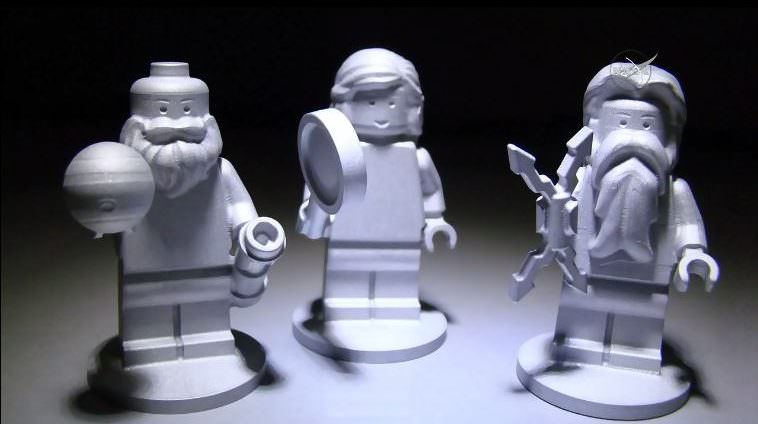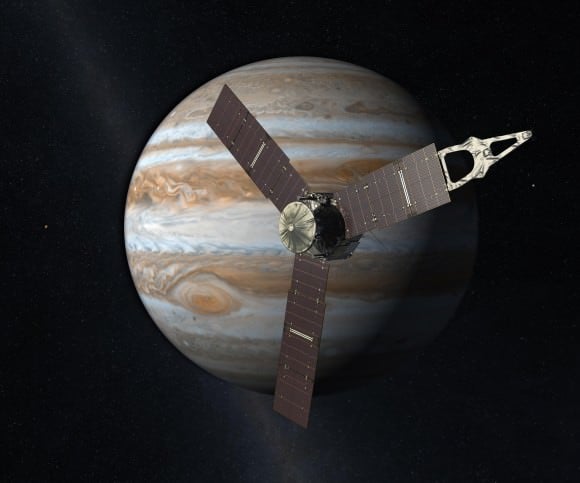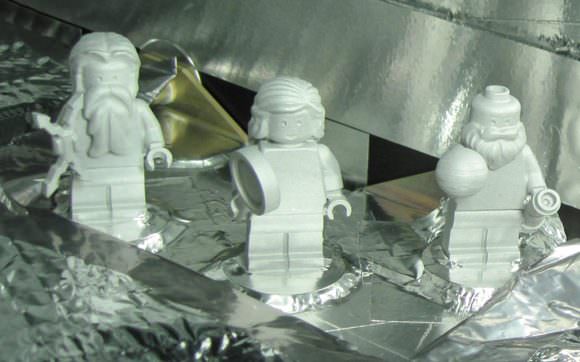Given its historic importance - being just the second spacecraft to conduct a long-term mission to Jupiter - NASA was sure to outfit the
Juno probe
with some high-end memorabilia. These include the Galileo commemorative plaque*, which shows Galileo's face and the words he wrote when he first observed Jupiter's four
largest moons in 1610
(known today as the
Galilean Moons
).
In addition, three commemorative figures (each measuring 4 cm high) were created especially for the mission. Created by
Lego
, these figurines depict the Roman god Jupiter, his wife Juno, and the astronomer Galileo Galilei - each holding an identifying object. Constructed from aluminum so they could withstand the trip and the radiation of the gas giant, these figures arrived with the probe around Jupiter on Monday, July 4th.
Much like the
Juno
spacecraft that is ferrying them, these figurines have spent the past 5 years in space and traversing the 869 million kilometers that lie between Earth from Jupiter. As part of Lego's "
Build Your Future
" campaign, the trio are part of an educational outreach program to inspire kids around the world to learn about science and technology.
A key part of this effort is the Building Challenge launched by Lego to raise awareness about space exploration. For this challenge, participants are asked to build their vision of the future of space exploration using Lego bricks, take pictures of their creation, and then upload them to the Lego website's "
Mission to Space
" gallery. The winning creations will be featured on LEGO.com and the Gallery homepage.
[caption id="attachment_128262" align="aligncenter" width="580"]
NASA's Juno spacecraft launched on August 6, 2011 and should arrive at Jupiter on July 4, 2016. Credit: NASA / JPL
[/caption]
In addition, Lego's website has new content that encourages children to learn more about the Solar System. As they state on the webpage:
True to their mythological roots, the figurine of Jupiter (the Roman equivalent of Zeus) is holding a lightning bolt. Juno, his wife, is holding a magnifying glass, which represents her ability to see through the clouds that Jupiter surrounded himself with. And Galileo, the famed astronomer who was the first to view Jupiter's moons, holds his famed telescope and an orb representing Jupiter.
These three figurines are the closest thing the
Juno
spacecraft has to a crew. During the next two years, they will be with the probe as it orbits Jupiter a total of 37 times, conducting surveys of Jupiter's atmosphere, interior, magnetosphere, and gravitational field. When the mission is over, they will deorbit with the probe, crashing into Jupiter's atmosphere to prevent any contamination of Jupiter's moons.
[caption id="attachment_129781" align="aligncenter" width="580"]
Three LEGO figurines representing the Roman god Jupiter, his wife Juno and Galileo Galilei are shown here aboard the Juno spacecraft. Credits: NASA/JPL-Caltech/KSC
[/caption]
Over the course of the past three days, numerous memes have popped up across the internet, claiming that:
"When Galileo first spotted Jupiter's largest moons, he named them after Jove's (Zeus') mistresses. Now, a probe named after his wife will arrive in the system, thus fulfilling a joke astronomers have been setting up for the past 400 years!" -
I'm paraphrasing, of course!
Nevertheless, the observation is an apt one. And to make this witty statement complete, all those figures who had a hand in lending Jupiter the cultural significant it has (be they historical or mythological) will be represented as
Juno
tries to unveil Jupiter's mysteries. Sure, those likenesses are just 4 cm in height, and they are built out of aluminum instead of marble, but it's the thought that counts!
*The Galileo commemorative plague contains script written in Italian by Galileo's own hand. It reads:
And be sure to enjoy this video of NASA's Juno team celebrating the probe's arrival at Jupiter:
 Universe Today
Universe Today


